Dc converter
a direct-current converter and converter technology, applied in the direction of electric variable regulation, process and machine control, instruments, etc., can solve the problems of increasing switching noise and very unstable operation of direct-current converters, and achieve the effect of improving the unstableness of operations, eliminating the influence of delay, and increasing switching nois
- Summary
- Abstract
- Description
- Claims
- Application Information
AI Technical Summary
Benefits of technology
Problems solved by technology
Method used
Image
Examples
first embodiment
[0032]FIG. 3 is a circuitry diagram of a direct-current converter according to a first embodiment. In the direct-current converter shown in FIG. 3, a main switch Q1 and an auxiliary switch Q2 are configured to be alternately switched on / off by PWM control of a control circuit 11. Based on an output voltage of a load 30, the control circuit 11 generates a control signal formed of a pulse for controlling ON / OFF of the main switch Q1, and controls a duty ratio of the control signal so that the output voltage becomes a predetermined voltage.
[0033] Moreover, the direct-current converter includes an inverter 12, a bottom detection circuit 13, a first delay circuit 14, a second delay circuit 15, a low-side driver 16, a high-side driver 17, an ideal gate signal generation circuit 21, a comparison circuit 22, and an integration circuit 23.
[0034] The inverter 12 inverts a Q1 control signal Q1c for the main switch Q1 from the control circuit 11, and outputs the inverted Q2 control signal Q2c...
second embodiment
[0050]FIG. 6 is a circuitry diagram of a direct-current converter according to a second embodiment. The direct-current converter according to the second embodiment, which is shown in FIG. 6, provides a specific circuit example of the direct-current converter according to the first embodiment.
[0051] In the bottom detection circuit 13 shown in FIG. 6, a cathode of a diode D1, one end of a resistor R1 and one end of a resistor R10 are connected to a base of a transistor Q3, and an emitter of the transistor Q3 is connected to an anode of the diode D1, and grounded. One end of a resistor R2 is connected to a collector of the transistor Q3, and the other end of the resistor R1 and the other end of the resistor R2 are connected to a power supply Vcc. The other end of the resistor R10 is connected to a drain of the main switch Q1 through a capacitor C1.
[0052] The ideal gate signal generation circuit 21 includes an inverter 211, an inverter 212, and a D-type flip-flop (DFF) 213. The invert...
third embodiment
[0071]FIG. 8 is a circuitry diagram of a direct-current converter according to a third embodiment. The direct-current converter according to the third embodiment, which is shown in FIG. 8, is one which obtains a direct-current output by switching on / off the main switch. The direct-current converter according to the third embodiment is characterized in that the auxiliary switch Q2, the inverter 12, the second delay circuit 15, the high-side driver 17, the capacitor C2, the diode D11 and the reactor L10 are deleted from the configuration of the direct-current converter according to the first embodiment, which is shown in FIG. 3. Moreover, the primary winding P1 and secondary winding S1 of the transformer T are wound in phases reverse to each other.
[0072] Other configurations shown in FIG. 8 are the same as the configurations of the constituent portions shown in FIG. 3. The same reference numerals are assigned to the same portions, and description thereof is omitted.
[0073] Next, oper...
PUM
 Login to View More
Login to View More Abstract
Description
Claims
Application Information
 Login to View More
Login to View More - R&D
- Intellectual Property
- Life Sciences
- Materials
- Tech Scout
- Unparalleled Data Quality
- Higher Quality Content
- 60% Fewer Hallucinations
Browse by: Latest US Patents, China's latest patents, Technical Efficacy Thesaurus, Application Domain, Technology Topic, Popular Technical Reports.
© 2025 PatSnap. All rights reserved.Legal|Privacy policy|Modern Slavery Act Transparency Statement|Sitemap|About US| Contact US: help@patsnap.com



